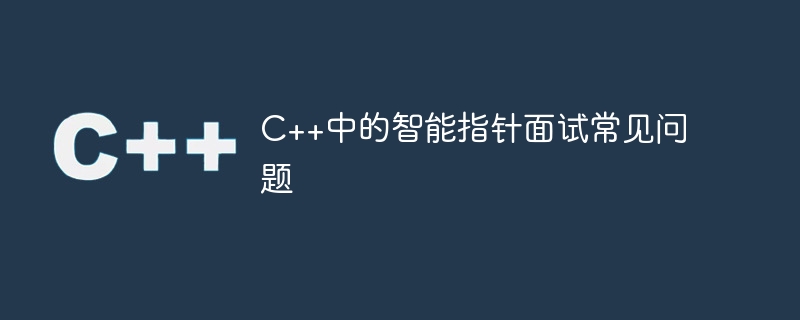Home >Backend Development >C++ >Smart pointers in C++ interview FAQs
Smart pointers in C++ interview FAQs
- WBOYWBOYWBOYWBOYWBOYWBOYWBOYWBOYWBOYWBOYWBOYWBOYWBOriginal
- 2023-08-22 15:06:201198browse

In C, smart pointers have become a common programming technology, which can help developers manage memory and avoid program crashes due to memory leaks, wild pointers and other issues. However, interviewers often ask questions related to smart pointers to test the candidate's understanding and mastery of memory management. Here are a few common smart pointer interview questions.
- What is a smart pointer?
A smart pointer is a pointer-like object that can manage dynamically allocated memory and avoid memory leaks. Smart pointers can keep track of the objects they manage and automatically release them when they are no longer needed. There are two main types of smart pointers: shared_ptr and unique_ptr.
- What is the difference between unique_ptr and shared_ptr?
unique_ptr and shared_ptr are both smart pointers, but their main difference is how memory ownership is managed. unique_ptr is an exclusive smart pointer that can have sole ownership of an object and cannot be copied. And shared_ptr is a shared smart pointer that can share ownership between multiple objects, so it can be copied.
In addition, unique_ptr can transfer the ownership of the object through the std::move function, while shared_ptr does not have this function. Since unique_ptr can only be owned by one object, its memory management method is safer.
- What happens if I have a shared_ptr pointing to an object, and I declare a weak_ptr pointing to the same object?
When an object only has weak_ptr pointing to it, its reference count will not be increased. Therefore, even if weak_ptr exists, if all shared_ptr have been destroyed, then this object will be released. When there is still a shared_ptr pointing to this object, weak_ptr can obtain a valid shared_ptr through the lock() function to ensure that the object will not be released during the acquisition.
- How is an object released when all its shared_ptrs are destroyed?
shared_ptr uses reference counting to track the ownership of the object. The standard library maintains a counter to record how many shared_ptr points to an object. When the counter reaches 0, the object is automatically released to avoid memory leaks. This is because shared_ptr maintains a reference count, which records how many shared_ptr point to the same object. When the last shared_ptr is destroyed, the reference count becomes zero, and the heap memory pointed to will be released at the same time.
- How to ensure that smart pointers do not cause circular references?
Circular reference refers to two or more objects holding the shared_ptr of other objects to each other, forming a cycle. In this case, since the reference count is not 0, the object will not be released, resulting in a memory leak. In order to avoid circular references, weak_ptr is generally used to manage references to objects that do not hold ownership, thereby breaking the circular reference ring. At the same time, we can also use std::enable_shared_from_this, which can provide a member function shared_from_this() for a class. This function can return a shared_ptr pointing to this object. In this way, if an object in a class needs the shared_ptr of another class, it does not need to hold the shared_ptr of the object, but can obtain a valid shared_ptr by calling the shared_from_this() function of the object, avoiding the problem of circular reference.
Summary
Smart pointers are an important memory management method in C, which can effectively avoid problems such as memory leaks and wild pointers. During the interview, understanding the various characteristics and usage scenarios of smart pointers is key. It not only shows the understanding and mastery of the C language, but also shows the applicant's code security awareness and excellent programming capabilities.
The above is the detailed content of Smart pointers in C++ interview FAQs. For more information, please follow other related articles on the PHP Chinese website!

